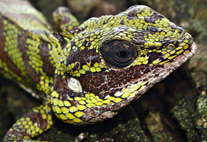Abstract
A new species of agamid lizard, of the genus Calotes, is described based on morphological evidence. This species is restricted to the Knuckles massif (>900 m elevation) of Sri Lanka. The genus Calotes consists of seven species in Sri Lanka, five of which appear to form an endemic radiation. The new species most closely resembles C. liocephalus Günther, 1872 which has an isolated population in the central highlands and is only known from Pundaluoya (~1000m), Dickoya (~1200m), Upcot (~1400m), Agrapatanas (1665m) and Peak Wilderness (Sri Pada) (>1400m). The populations from Pundaluoya and Dickoya appear to be locally extinct from the wild and are known only from museum specimens collected over 120 years ago. Males of the new species are different from males of C. liocephalus because of the absence of a gular pouch; by having mid gular scales smaller in size than those of its counterpart; scales on the snout which are larger in size than those on the occipital and forehead; pectoral scales which are not enlarged; elongated subcaudal scales; slightly carinate and acuminate abdominal scales; and scales on venter which are somewhat larger in size than those on dorsum at the same level. Finally, we also redescribe Calotes liocephalus, and provide a key to the Sri Lankan species of genus Calotes.

